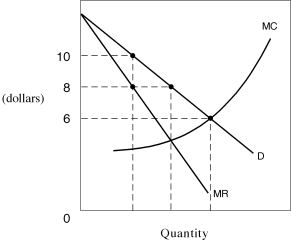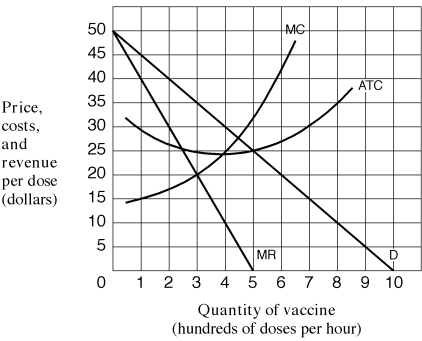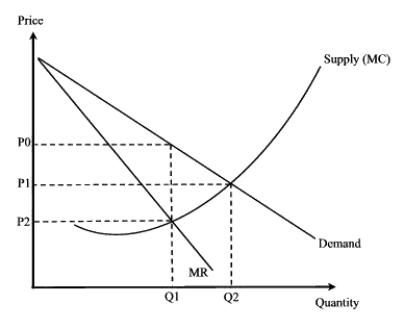A) Legal barriers like government franchises.
B) Economies of scale.
C) Ownership of a vital resource.
D) Patents and copyrights.
Correct Answer

verified
Correct Answer
verified
Multiple Choice
What should a profit-maximising monopolist do if she is currently producing where MC < MR?
A) Increase output until MC = MR.
B) Decrease output until MC = MR.
C) Shut down in the long run.
D) Keep producing at this level.
Correct Answer

verified
Correct Answer
verified
Multiple Choice
A casino is often protected by license because:
A) it is helping gamblers to access the services.
B) it allows the casino to enjoy the competitive pricing.
C) it creates a stream of revenue to the government.
D) it invites more casinos to open.
Correct Answer

verified
Correct Answer
verified
Multiple Choice
Marginal revenue can be:
A) never negative.
B) always positive.
C) only zero.
D) zero, positive or negative.
Correct Answer

verified
Correct Answer
verified
Multiple Choice
Narrbegin Exhibit 8.6 Monopolist  -According to the information provided in Exhibit 8.6, if the Rudd Ice Company is a monopoly and is currently charging a price of $8, what would you advise Rudd to do?
-According to the information provided in Exhibit 8.6, if the Rudd Ice Company is a monopoly and is currently charging a price of $8, what would you advise Rudd to do?
A) Stay where he is currently operating because he is charging the profit-maximising price.
B) Increase price and increase output.
C) Decrease price and increase output.
D) Increase output and hold price constant.
Correct Answer

verified
Correct Answer
verified
Multiple Choice
Bus services often offer lower prices for students and pensioners because:
A) they have a more inelastic demand for bus services.
B) its the right thing to do morally.
C) they have a higher elasticity for bus services than the adult working population.
D) they have a higher willingness to pay.
Correct Answer

verified
Correct Answer
verified
Multiple Choice
The most effective barrier/s to protect a monopoly from competition is/are:
A) legal barriers or government ownership.
B) excessive advertising by the monopoly.
C) higher wages paid to the monopoly's workers.
D) the high quality product offered by a monopoly.
Correct Answer

verified
Correct Answer
verified
Multiple Choice
Narrbegin Exhibit 8.6 Monopolist  -According to the information provided in Exhibit 8.6, if the Rudd Ice Company is a monopoly and is currently charging a price of $10, what would you advise Rudd to do?
-According to the information provided in Exhibit 8.6, if the Rudd Ice Company is a monopoly and is currently charging a price of $10, what would you advise Rudd to do?
A) Stay where he is currently operating because he is charging the profit-maximising price.
B) Increase price and increase output.
C) Decrease price and increase output.
D) Increase output and hold price constant.
Correct Answer

verified
Correct Answer
verified
Multiple Choice
Competition means:
A) that a society's wealth is maximised.
B) that a society experiences a deadweight loss.
C) high prices and less goods.
D) that a society misallocates its resources.
Correct Answer

verified
Correct Answer
verified
Multiple Choice
At a price of $5, 24 units of a good would be sold. At a price of $10, 25 units of output would be sold. The marginal revenue of the 25th unit of output is:
A) $14.
B) $55.
C) $100.
D) $130.
Correct Answer

verified
Correct Answer
verified
Multiple Choice
For a monopolist to practise price discrimination, one necessary condition is that the product offered for sale must be:
A) high quality.
B) expensive.
C) cheap.
D) impossible or difficult to resell.
Correct Answer

verified
Correct Answer
verified
Multiple Choice
The monopolist can choose:
A) any price for its product.
B) the demand curve.
C) price and quantity to produce.
D) price or quantity to produce.
Correct Answer

verified
Correct Answer
verified
Multiple Choice
The only hairdresser in a small town is an example of:
A) monopsy.
B) luxury.
C) monopoly.
D) oligopoly.
Correct Answer

verified
Correct Answer
verified
Multiple Choice
Narrbegin Exhibit 8.3 Demand and cost curves for GeneTech, a monopolist with a patented vaccine  -In Exhibit 8.3, what is the maximum hourly profit that GeneTech can earn from its vaccine?
-In Exhibit 8.3, what is the maximum hourly profit that GeneTech can earn from its vaccine?
A) $1500.
B) $3000.
C) $4500.
D) $10 500.
Correct Answer

verified
Correct Answer
verified
Multiple Choice
A single priced monopoly:
A) can increase price and increase output at the same time.
B) can charge any price it wants and still sell all of its output.
C) can sell any output it produces provided it accepts the market price.
D) must lower price in order to increase output.
Correct Answer

verified
Correct Answer
verified
Multiple Choice
Narrbegin Exhibit 8.7  -According to Exhibit 8.7, the price a monopolist would charge is:
-According to Exhibit 8.7, the price a monopolist would charge is:
A) P0.
B) P1.
C) P2.
D) indeterminate as there is not enough information provided.
Correct Answer

verified
Correct Answer
verified
Multiple Choice
In contrast to a perfectly competitive firm, a monopolist operates in the long run at a quantity of output at which:
A) P = MC.
B) MR = MC.
C) P = ATC.
D) P > MR.
Correct Answer

verified
Correct Answer
verified
Multiple Choice
Suppose a monopolist charges a price corresponding to the intersection of the marginal cost and marginal revenue curves. If the price is between its average variable cost and average total cost curves, the firm will:
A) earn an economic profit.
B) stay in operation in the short run, but shut down in the long run if demand remains the same.
C) shut down.
D) charge a higher price.
Correct Answer

verified
Correct Answer
verified
Multiple Choice
Which of the following statements is true?
A) One reason a monopoly can earn economic profits is because it can raise price and restrict output.
B) A perfectly competitive firm can earn economic profits because it can raise price and restrict output.
C) Income is transferred from producers to consumers in a monopoly compared to perfect competition.
D) Monopolists who price-discriminate rarely earn positive economic profits in the long run.
Correct Answer

verified
Correct Answer
verified
Multiple Choice
A recent study has concluded that working adults have a price elasticity of demand of 1.72 for train services, while pensioners have a price elasticity of demand of 3.74. If price discrimination is possible, then the company providing the train service will:
A) charge a lower price to working adults than to pensioners.
B) charge a lower price to pensioners than to working adults.
C) earn higher profits by charging everyone the same price.
D) lower prices for all customers because demand is elastic for both groups.
Correct Answer

verified
Correct Answer
verified
Showing 81 - 100 of 120
Related Exams